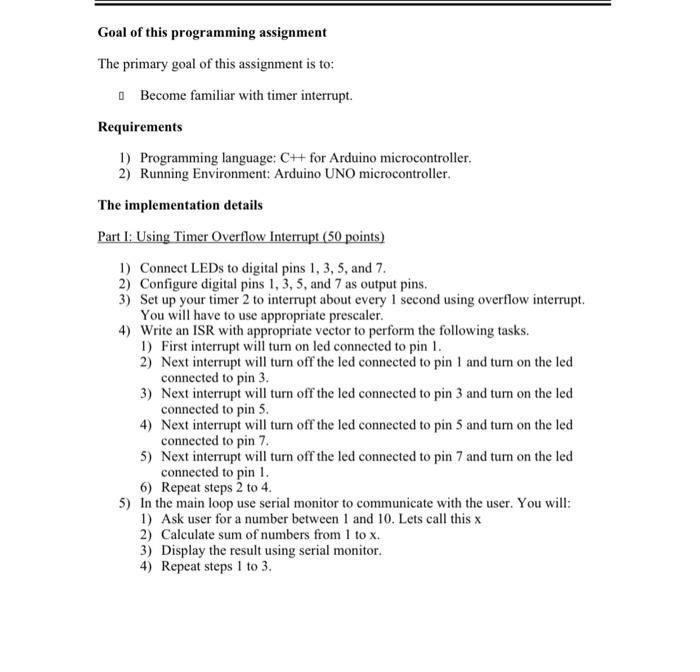Please show the arduino wire connections as well

Goal of this programming assignment The primary goal of this assignment is to: Become familiar with timer interrupt. Requirements 1) Programming language: C++ for Arduino microcontroller 2) Running Environment: Arduino UNO microcontroller. The implementation details Part 1: Using Timer Overflow Interrupt (50 points) 1) Connect LEDs to digital pins 1, 3, 5, and 7. 2) Configure digital pins 1, 3, 5, and 7 as output pins. 3) Set up your timer 2 to interrupt about every 1 second using overflow interrupt. You will have to use appropriate prescaler. 4) Write an ISR with appropriate vector to perform the following tasks. 1) First interrupt will turn on led connected to pin 1. 2) Next interrupt will turn off the led connected to pin 1 and turn on the led connected to pin 3. 3) Next interrupt will turn off the led connected to pin 3 and turn on the led connected to pin 5. 4) Next interrupt will turn off the led connected to pin 5 and turn on the led connected to pin 7. 5) Next interrupt will turn off the led connected to pin 7 and turn on the led connected to pin 1. 6) Repeat steps 2 to 4. 5) In the main loop use serial monitor to communicate with the user. You will: 1) Ask user for a number between 1 and 10. Lets call this x 2) Calculate sum of numbers from 1 to x. 3) Display the result using serial monitor. 4) Repeat steps 1 to 3. Goal of this programming assignment The primary goal of this assignment is to: Become familiar with timer interrupt. Requirements 1) Programming language: C++ for Arduino microcontroller 2) Running Environment: Arduino UNO microcontroller. The implementation details Part 1: Using Timer Overflow Interrupt (50 points) 1) Connect LEDs to digital pins 1, 3, 5, and 7. 2) Configure digital pins 1, 3, 5, and 7 as output pins. 3) Set up your timer 2 to interrupt about every 1 second using overflow interrupt. You will have to use appropriate prescaler. 4) Write an ISR with appropriate vector to perform the following tasks. 1) First interrupt will turn on led connected to pin 1. 2) Next interrupt will turn off the led connected to pin 1 and turn on the led connected to pin 3. 3) Next interrupt will turn off the led connected to pin 3 and turn on the led connected to pin 5. 4) Next interrupt will turn off the led connected to pin 5 and turn on the led connected to pin 7. 5) Next interrupt will turn off the led connected to pin 7 and turn on the led connected to pin 1. 6) Repeat steps 2 to 4. 5) In the main loop use serial monitor to communicate with the user. You will: 1) Ask user for a number between 1 and 10. Lets call this x 2) Calculate sum of numbers from 1 to x. 3) Display the result using serial monitor. 4) Repeat steps 1 to 3








